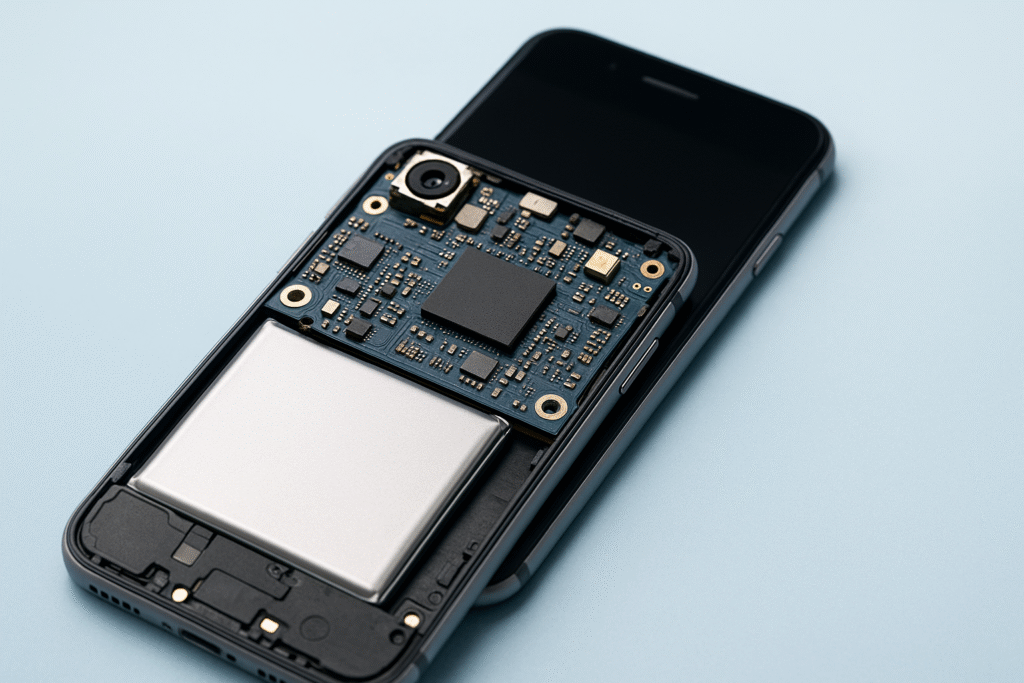Written by:James Whitaker

Have you ever noticed your phone charging slower than usual, overheating, or turning off unexpectedly — even when the battery isn’t empty? The problem might not be your charger or battery at all. It could be a failing Power Management Integrated Circuit (PMIC) — the hidden chip that regulates power throughout your phone.
At Mobile Fix Experts, our technicians regularly repair phones suffering from PMIC failure — one of the most overlooked but serious hardware issues. This post explains what the Power Management IC does, how it fails, the warning signs, and how you can prevent permanent battery or charging damage.
Section 1: What Is a Power Management IC (PMIC)?
The Brain Behind Power Distribution
Every smartphone contains a Power Management IC — a tiny but critical component that controls how electricity flows through your device. It ensures that every part — the screen, processor, camera, and battery — gets just the right amount of power.
Without a functioning PMIC, your phone can’t charge properly, won’t regulate voltage, and may even shut down randomly.
How the PMIC Works
Here’s what the Power Management IC does every second your phone is on:
- Regulates battery charging and discharging.
- Protects against voltage spikes or short circuits.
- Converts electrical current from charger to the correct voltage for each component.
- Balances energy between performance and temperature.
In short, it’s the heart of your phone’s electrical system — silently managing power stability every moment.
Section 2: What Causes a PMIC to Fail?
PMIC failure doesn’t happen overnight. It’s usually the result of stress, poor-quality accessories, or physical damage.
1. Power Surges from Cheap Chargers
The number one cause of PMIC damage is inconsistent voltage. Using cheap or counterfeit chargers sends unstable current into your phone, overloading the PMIC and damaging its circuits.
That’s why we always recommend genuine or certified accessories available through Buy a Device or verified sellers at Mobile Fix Experts.
2. Heat and Overuse
Excessive heat accelerates chip degradation. If your phone often gets hot during charging or gaming, your PMIC is under constant strain. Over time, heat breaks down the solder joints that connect the chip to the motherboard.
To prevent this, avoid heavy multitasking while plugged in — or bring your phone to Repair a Device if overheating becomes frequent.
3. Water or Liquid Damage
Even minimal moisture can cause electrical shorting. The PMIC, being a sensitive component, can fail if water enters through a damaged charging port or micro-crack. Our team at Mobile Fix Experts specializes in restoring water-damaged phones before corrosion spreads to the PMIC.
4. Manufacturing Defects or Physical Impact
Sometimes, a phone’s design flaw or factory error causes premature chip failure. Drops or shocks can also dislodge microscopic solder connections. When this happens, your phone may still turn on but exhibit unstable charging or battery drain.
Section 3: Signs of a Failing Power Management IC
Identifying PMIC failure early can save your phone from total breakdown. Here are the most common symptoms we see at Mobile Fix Experts:
1. Slow or No Charging
If your phone charges inconsistently or not at all — even with different cables or adapters — your PMIC may not be properly regulating voltage.
2. Sudden Shutdowns
Your phone might turn off even at 30–40% battery, or restart repeatedly without warning. This happens when the PMIC can’t supply steady power.
3. Overheating During Charging
Constant overheating indicates the PMIC is struggling to distribute energy efficiently.
4. Incorrect Battery Readings
Seeing the battery jump from 70% to 10% instantly? That’s a classic sign of poor power calibration caused by a faulty PMIC.
5. No Response After Battery Replacement
If you’ve replaced your battery and the issue persists, it’s likely the PMIC — not the battery — that needs repair.
Section 4: How PMIC Failure Impacts Battery Health and Charging
When the Power Management IC malfunctions, it directly affects both charging and long-term battery performance.
Voltage Instability
A failing PMIC sends inconsistent voltage to the battery. This leads to:
- Overcharging or undercharging cycles.
- Battery swelling.
- Reduced lifespan due to heat and electrical stress.
Irregular Power Supply
Even when not charging, the PMIC regulates internal power flow. Faulty chips can cause constant micro-drains, meaning your phone loses power faster even when idle.
Charging Port Miscommunication
PMIC issues can mimic port problems — your phone may not recognize the charger, or it might keep toggling between “charging” and “not charging.”
If these problems sound familiar, our team at Mobile Fix Experts can run a diagnostic to confirm whether your issue lies in the PMIC, the port, or the battery.
Section 5: Can a Faulty PMIC Be Repaired?
Yes — but it requires micro-soldering expertise. The PMIC is soldered directly onto the motherboard using dozens of tiny contact points. Replacing it involves desoldering the damaged chip and carefully installing a new one under a microscope.
At Mobile Fix Experts, our trained board technicians specialize in chip-level repairs. Using professional-grade rework stations, they can restore charging functionality safely and reliably — often without replacing the entire motherboard.
Section 6: Preventing PMIC Failure — Proactive Care Tips
You can greatly extend your phone’s lifespan by following these PMIC-safe habits:
- Use only certified chargers and cables. Avoid low-cost third-party accessories.
- Keep your phone cool. Remove thick cases while charging.
- Avoid heavy multitasking during charging. It reduces power stress on internal circuits.
- Don’t charge from unreliable power sources. Car chargers or unstable outlets can trigger power surges.
- Schedule periodic checkups. Visit Mobile Fix Experts for inspections every few months to catch early power issues.
Section 7: Why PMIC Replacement is Not a DIY Fix
Replacing a PMIC without professional tools can cause irreparable motherboard damage. The process requires precision heat control and micro-soldering skills. Even slight overheating during the repair can warp nearby chips.
That’s why professional intervention through Repair a Device is the safest and most cost-effective approach.
Section 8: Real-World Example — A PMIC Repair Case
One customer brought in an iPhone that wouldn’t charge after a third-party battery swap. Our technicians tested the logic board and found the PMIC had shorted during installation. After replacing the IC and recalibrating the charging system, the phone charged perfectly again — saving the customer from a full device replacement.
This example shows how even minor electrical stress can trigger PMIC failure — but with expert diagnostics, it’s fully repairable.
Section 9: When to Replace Instead of Repair
In some cases, PMIC damage extends to multiple components. If your phone is very old or has multiple board-level failures, replacing the device may be more practical. Our Sell a Device page allows you to trade in damaged phones for credit toward a new or refurbished one.
Section 10: When to Visit Mobile Fix Experts
If you experience repeated charging failures, excessive battery drain, or sudden shutdowns — it’s time for professional help.
Our certified board repair specialists diagnose PMIC failures using advanced tools and provide fast, affordable solutions. Whether it’s replacing the chip or recalibrating power flow, Mobile Fix Experts ensures your device regains peak performance.
FAQs
Q1: What happens if my PMIC fails completely?
Your phone won’t charge or power on at all. The only fix is chip replacement by a qualified technician.
Q2: How long does PMIC repair take?
Typically, 1–3 business days depending on model and part availability.
Q3: Can I prevent PMIC failure with software updates?
Not entirely. Software optimizes charging behavior, but hardware still depends on safe voltage control.
Q4: Is PMIC failure common?
Yes — especially in phones frequently exposed to cheap chargers or overheating.
Q5: Is PMIC replacement expensive?
It’s more affordable than a full motherboard replacement and usually extends the device’s life significantly.
Disclaimer
The information in this blog is for educational purposes only. Power-management IC repairs require professional equipment and training. For accurate diagnostics and safe repair, contact Mobile Fix Experts.
